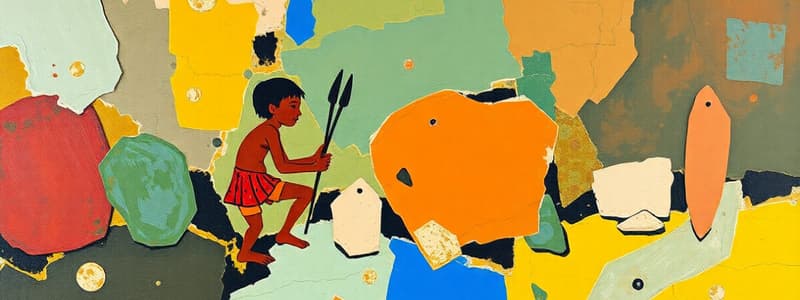Podcast
Questions and Answers
What was the primary driving force behind the technological developments of the early Filipinos?
What was the primary driving force behind the technological developments of the early Filipinos?
- The desire to create art and express themselves aesthetically.
- The need to trade with neighboring islands and establish economic relationships.
- The influence of advanced technologies from colonizing countries.
- The primal necessity for survival by hunting and gathering resources. (correct)
Which material did early Filipinos discover could be hardened by sun-drying after being mixed with water and shaped?
Which material did early Filipinos discover could be hardened by sun-drying after being mixed with water and shaped?
- Iron
- Gold
- Bronze
- Clay (correct)
The smelting of which metals demonstrated the primitive Filipino's knowledge of alloy composition and optimal temperatures?
The smelting of which metals demonstrated the primitive Filipino's knowledge of alloy composition and optimal temperatures?
- Silver and Platinum
- Aluminum and Zinc
- Lead and Mercury
- Copper, Gold, Bronze and Iron (correct)
What does the construction of the Banaue Rice Terraces by the Ifugaos exemplify?
What does the construction of the Banaue Rice Terraces by the Ifugaos exemplify?
What did the early Filipinos' shift towards settling near water sources indicate?
What did the early Filipinos' shift towards settling near water sources indicate?
Which scientific principle is most evident in the ancient crafts of stone carving, pottery, and smelting of metals?
Which scientific principle is most evident in the ancient crafts of stone carving, pottery, and smelting of metals?
What characterizes the relationship between primitive Filipinos and nature, as inferred from their technological advancements?
What characterizes the relationship between primitive Filipinos and nature, as inferred from their technological advancements?
Which of the following best describes the evolution of technology among early Filipinos?
Which of the following best describes the evolution of technology among early Filipinos?
What factor significantly impeded the progress of Filipino professionals in advancing their knowledge and contributing to society during the Spanish regime?
What factor significantly impeded the progress of Filipino professionals in advancing their knowledge and contributing to society during the Spanish regime?
Which of the following best describes Dr. Jose Rizal's contribution to technology during his exile in Dapitan?
Which of the following best describes Dr. Jose Rizal's contribution to technology during his exile in Dapitan?
What was the primary focus of scientific research conducted in charity hospitals during the Spanish era?
What was the primary focus of scientific research conducted in charity hospitals during the Spanish era?
What was the main purpose of the Laboratorio Municipal de Ciudad de Manila, established in 1887?
What was the main purpose of the Laboratorio Municipal de Ciudad de Manila, established in 1887?
Why did the industries in the Philippines not prosper significantly during the Spanish regime, despite scientific research efforts?
Why did the industries in the Philippines not prosper significantly during the Spanish regime, despite scientific research efforts?
Which factor primarily drove the modernization of certain sectors like sugar and hemp production in the Philippines during the Spanish era?
Which factor primarily drove the modernization of certain sectors like sugar and hemp production in the Philippines during the Spanish era?
What evidence suggests the presence of scientific activity in the Philippines during the Spanish colonial era?
What evidence suggests the presence of scientific activity in the Philippines during the Spanish colonial era?
Which of the following can be considered technological contributions of Jose Rizal?
Which of the following can be considered technological contributions of Jose Rizal?
How did the Spanish colonization influence the Philippine economy?
How did the Spanish colonization influence the Philippine economy?
What was a major obstacle the persistent Filipino scientists faced during the Spanish era?
What was a major obstacle the persistent Filipino scientists faced during the Spanish era?
Flashcards
Early Stone Tools
Early Stone Tools
Early Filipinos developed tools and weapons from stone through sawing, drilling, and polishing.
Tech's Origin
Tech's Origin
Technology evolved from basic survival needs like hunting and gathering.
Early Pottery
Early Pottery
Mixing clay with water and sun-drying it creates hardened, useful objects.
Metal Extraction
Metal Extraction
Signup and view all the flashcards
Metal Smelting
Metal Smelting
Signup and view all the flashcards
Early Industries
Early Industries
Signup and view all the flashcards
Science in Crafts
Science in Crafts
Signup and view all the flashcards
Banaue Terraces
Banaue Terraces
Signup and view all the flashcards
Beginnings of Philippine Science
Beginnings of Philippine Science
Signup and view all the flashcards
Santo Tomas University
Santo Tomas University
Signup and view all the flashcards
Church's Influence on Science
Church's Influence on Science
Signup and view all the flashcards
Dr. Jose Rizal's Expertise
Dr. Jose Rizal's Expertise
Signup and view all the flashcards
Rizal's Engineering Feat
Rizal's Engineering Feat
Signup and view all the flashcards
Hospitals as Research Hubs
Hospitals as Research Hubs
Signup and view all the flashcards
Laboratorio Municipal's Role
Laboratorio Municipal's Role
Signup and view all the flashcards
First Scientific Journal
First Scientific Journal
Signup and view all the flashcards
Spanish Research Focus
Spanish Research Focus
Signup and view all the flashcards
Agricultural Economy
Agricultural Economy
Signup and view all the flashcards
Study Notes
- During the pre-Spanish era, archaeological evidence indicates that the earliest inhabitants of the Philippines, residing in Palawan and Batangas around 40,000 years ago, crafted rudimentary tools and weapons from stone.
- They progressively refined techniques for sawing, drilling, and polishing hard stones, driven by the basic need to hunt and gather food.
- Polishing hard stones enabled them to create sharper tools for daily tasks, illustrating that technology arose from necessity.
- Early Filipinos learned to combine clay with water, shape it, and then sun-dry it to create hardened, useful objects.
- They discovered how to extract, smelt, and refine metals such as copper, gold, bronze, and iron from the environment, which they then fashioned into tools.
- As they transitioned from nomadic lifestyles to settling near water sources, they also learned to weave cotton, engage in agriculture, and construct boats for coastal trade.
- Primitive Filipinos practiced science and technology daily through crafts like stone carving, pottery, and metal smelting, demonstrating an understanding of the nature of matter.
- The Ifugaos' construction of the Banaue Rice Terraces and metal smelting showed knowledge of alloy composition and optimal temperatures for producing metals with acceptable strength.
- Overall, early Filipinos lived in harmony with nature, extracting what they needed through a simple understanding of natural processes.
Spanish Colonial Era
- Modern science and technology in the Philippines began during the Spanish regime with the establishment of schools, hospitals, and scientific research initiatives.
- These schools, primarily run by Spanish friars, produced the first Filipino professionals, with the Royal and Pontifical University of Santo Tomas as the highest learning institution.
- The Church's strict control and intervention in government hindered the progress of Filipino professionals, limiting their ability to enhance knowledge, conduct research, and contribute to societal advancement.
- Some Filipino scientists, like Dr. Jose P. Rizal, succeeded by pursuing education abroad.
- Dr. Rizal, considered a Renaissance man, excelled as a scientist, doctor, engineer, journalist, novelist, urban planner, and designed and built a water system in Dapitan.
- Charity hospitals fostered scientific research in pharmacy and medicine, focusing on infectious diseases, their causes, and potential treatments.
- The Laboratorio Municipal de Ciudad de Manila, established in 1887, conducted biochemical analyses for public health and specimen examinations for clinical and medico-legal cases.
- Its publication, Cronica de Ciencias Medicas de Filipinas, was likely the first scientific journal in the country.
- The Spanish exploited the country's natural resources through agriculture, mining, and establishing industries.
- Scientific research related to these fields was encouraged by the government.
- By the nineteenth century, Manila became a cosmopolitan center with modern amenities.
- Limited scientific research and its translation into technology resulted in stagnation of most industries.
- The Philippines became a primary agricultural exporting economy due to foreign capital and technology, which modernized sectors like sugar and hemp production.
Studying That Suits You
Use AI to generate personalized quizzes and flashcards to suit your learning preferences.




